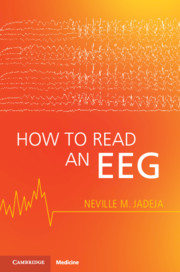Book contents
- How to Read an EEG
- How to Read an EEG
- Copyright page
- Dedication
- Contents
- Figure Contributions
- Foreword
- Preface
- How to Read This Book
- Part I Basics
- Part II Interpretation
- Part III Specific Conditions
- Chapter 18 Common Seizure Mimics
- Chapter 19 Seizures
- Chapter 20 Epilepsies
- Chapter 21 Epilepsy Syndromes
- Chapter 22 Focal Dysfunction (Lesions)
- Chapter 23 Global Dysfunction (Encephalopathy)
- Chapter 24 Status Epilepticus
- Chapter 25 Post Cardiac Arrest
- Chapter 26 Brain Death
- Appendix How to Write a Report
- Index
- References
Chapter 22 - Focal Dysfunction (Lesions)
from Part III - Specific Conditions
Published online by Cambridge University Press: 24 June 2021
- How to Read an EEG
- How to Read an EEG
- Copyright page
- Dedication
- Contents
- Figure Contributions
- Foreword
- Preface
- How to Read This Book
- Part I Basics
- Part II Interpretation
- Part III Specific Conditions
- Chapter 18 Common Seizure Mimics
- Chapter 19 Seizures
- Chapter 20 Epilepsies
- Chapter 21 Epilepsy Syndromes
- Chapter 22 Focal Dysfunction (Lesions)
- Chapter 23 Global Dysfunction (Encephalopathy)
- Chapter 24 Status Epilepticus
- Chapter 25 Post Cardiac Arrest
- Chapter 26 Brain Death
- Appendix How to Write a Report
- Index
- References
Summary
The EEG is poorly sensitive and specific to detect lesions compared to neuroimaging; its practical use is to determine the functional consequence of the lesion. Focal dysfunction (physiologic) may occur without an associated neuroimaging abnormality. Postictal states and hypoperfusion are examples of physiologic dysfunction; these are often reversible (disappear on repeat testing). Focal dysfunction causes disruption of the background architecture (wakefulness and sleep), asymmetric responses on activation procedures, and focal slowing. Severity of the focal dysfunction may be estimated based on the abundance of slowing, attenuation of amplitude, loss of reactivity, and increase of slower frequencies. Sporadic, intermittent, or fluctuating focal slowing that is reactive to external stimulation or endogenous state changes (such as arousal) may indicate physiological dysfunction. Focal intermittent rhythmic (monomorphic) delta activity such as Lateralized rhythmic delta activity (LRDA) specifically indicates epileptogenicity. It should be treated like an epileptic discharge despite the lack of a sharpness. Look for epileptic discharges that may accompany focal slowing. Focal slowing may occur in isolation, bilaterally, or in the setting of diffuse cerebral dysfunction.
Information
- Type
- Chapter
- Information
- How to Read an EEG , pp. 214 - 218Publisher: Cambridge University PressPrint publication year: 2021
